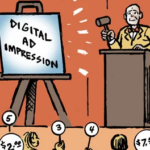 “Data-Driven Thinking” is a column written by members of the media community and containing fresh ideas on the digital revolution in media.
“Data-Driven Thinking” is a column written by members of the media community and containing fresh ideas on the digital revolution in media.
Today’s column is written by Jonathan Mendez, founder of Yieldbot.
Context comes from the Latin word contexere. The literal meaning is “joining together by weaving”. The Greeks had a word not just for context but also for the very moment someone weaves together two textures – “Kairos”. Context and timing have been pillars of persuasion since Aristotle.
In today’s world links weave media together and clicks are those most valuable moments when it is joined. With context built into the structure of the web it’s no accident the three most successful digital ad platforms – Search, Email and Affiliate – have context at the core of persuasion. As we move forward into an ever more media fragmented yet always connected world we can easily see how the value of context and those moments are increasing.
For publishers, proof points that context creates the most value in digital media are Quigo and AdSense. Quigo stands as one of greatest digital ad technologies ever created. In many ways, especially around pricing, delivery and creative it was much more advanced than Applied Semantics (AdSense) started two years prior. However, it is the abundance of AdSense and its contextual advertising that is all over the web. AdSense is a $8B+ channel for GOOG, 30% of overall revenues and up 23% from last year. For publishers context remains king.
For advertisers, there is no better place for context and timing than Search. The ROI of Search is without question and its cross-platform future assured. In Search people control context with their own rules and the ad delivery is realtime. Search beautifully leverages the unique benefits of a user-controlled medium for persuasion.
In Display, ad performance and publisher value are handicapped by lack of context and timing. Having multiple graphic ads on a page is the largest issue. The concept of anchoring is a large part of context and ad research has shown that 1) people use adjacent and preceding ads as an anchor and 2) people assimilate and contrast ads with their evaluation of the adjacent or prior ads (In Search click paths query reinforcement and recognition stay in context). These are just problems with the context of ads – we all know about the issues of contextual relevance of ads to content. Ads craves context and I wonder how a future of retargeting and audience buying delivers it.
Taking a look at some emerging channels:
Facebook: Offers little context for advertisers. People come to FB to share, communicate and be a voyeur. Advertising has no thread into that. Facebook does have potential for contextual relevance around local but so far has done little. Look for that to change.
Twitter: When sharing and communication is self segmented intelligent systems can derive relevance and respond with timing. Twitter’s follow filter operates similar to the Search query giving users control over context. The challenges for Twitter are scale and timing.
Video: Google has announced user control and self-selection will be in their Video Ad Selector format. Again, user generated rules can deliver context and a system mirroring pieces of Search should see great results and higher media values.
What the current landscape has shown is that context must be part of the media. In fact context may be the only thing in the future that prevents the commoditization of digital media.
Looking ahead, here are some trends I see related to context:
- Mobile is all about context and location based services (LBS) can provide deep levels of context and timing.
- The emergence of realtime data streams and realtime media rules from publishers will deliver both timing and context.
- Open-source semantic and text mining technology will continue to improve ushering in a new generation of context tools.
- Attention and focus on creative testing and analytics will help the understanding of context.
- Open source APIs of contextual data collection and exhaust will allow intelligent systems to “mashup” multiple contextual data streams.
For Pubs: As all media becomes performance media the better they understand context from the visitor perspective the higher their media value and the greater return for advertisers. We know this formula already as much as we know that context is critical to brands and bringing their dollars online.
For Advertisers: Almost all the web’s value is in joining together its seams at the right time. Systems that understand and leverage context and timing will continue to thrive. Those that don’t will be bit players in the future of web monetization.
Follow Yieldbot (@yieldbot) and AdExchanger.com (@adexchanger) on Twitter.












